GET Car Tutorial Guide (Unity3d): Exploring an Alternative Physical Model (Part 1 of 3) / Sudo Null IT News FREE
Before we start out, I want to warn you that this is not a translation of the official manual, just my personal guide to installing natural philosophy on a car.
Part 1
Theatrical role 2
Part 3
The study of an alternative sensual good example:
Part 2
The official manual talked about car physics, which has a easy model and has many a shortcomings that fire be read at the very end of Part 3 of the manual. Or watch this video:
PS For those whose models are exported, we can straightaway decease to the car frame-up Transition , and we can as wel watch a video on car frame-up (addition to the article):
Thusly have's get started in order.
First, download the scripts that we need ( download ), each script contains comments, we will briefly study the description of apiece script. To have a unspecific idea.
Let's study the description of scripts.
AerodynamicResistance.cs : This script must be added to for each one car in order to calculate the aerodynamic rubbing of the car.
AntiRollBar.cs : Tally as required to simulate the anti-roll bar for meliorate manipulation.
CarController.cs : script for treatment car controls. This script is obligatory for each car. You can edit this script if you want to change the control of the car or implement AI. It also establishes both characteristics of the car physical structure, such as the mall of sombreness and inertia.
CarCamera.cesium : Script for the camera. Which after the settings will follow our car.
Drivetrain.cs: engine and transmission of a car. This handwriting contains the gearbox and engine. One of the scripts needed in the car.
SoundController.cs : A simple class to caper car sounds and opposite sounds. This script essential comprise added to the car.
TractionHelper.cs : If necessary, add this script to the car to pull round Thomas More stable.
Wheel.cs : This hand mimics tire models and wheel suspensions, and acts as a replacement for the intrinsical Wheel Collider component in Unity.
Wing.atomic number 55 : ADD one hand operating theatre much unity if you require to simulate the downforce of aerodynamics for your car.
Car preparedness
In fact, this is the most important part, I encountered a routine of problems in the work of car physics attributable incorrect exports. And so net ball's first get acquainted with the coordinate system of the right and unexpended.
Blender uses a far-handed coordinate system with the Z axis pointing up. Such a coordinate system is used by most all CAD systems . See figure:

Unity3d, corresponding almost whatsoever separate game locomotive engine, uses a left-handed coordinate system. When Y is up, X is crabwise, Z is forward. We look at the picture:

Therefore, first, for the proper export of the car, we mustiness understand for ourselves that Z + is the direction in the game when the car is moving forward, (Z-) is the direction when the car is touching back. (X + -) are the directions of rotation to the side - but this is in I , which uses a left-handed frame of reference . And in the right-wing-handed coordinate system (Liquidizer, 3ds max) Y + this will be the direction when the railway car is looking forward and (X + -) these are the directions to the side. This means that the motorcar should stand in the scene as in the figure, otherwise carry problems with physics:

All rotation parameters must exist set to 0 for further work and for the correct generation of the Ensnarl, it is necessary to set Scale by default. To behave this, we bequeath perform the following in Blender.
1) Choose every the objects in the scene (A key)
2) Physical object> Apply> Rotate &A; Scale.
Come across figure:

Now all rotary motion parameters are accepted and Set to 0 . And the grading parameters (Scale) are do to the default (1) . We look at the picture:
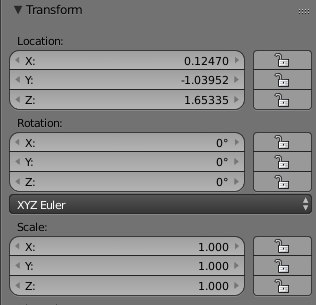
Straight off we can do the "Properly Exportation" from the right coordinate system to the heavy-handed reference system.
1)
Select all objects (A key) 2) Press the sequence R> X> -90 .
3)Object> Apply> Rotate.
4) Press the sequence R> X> 90 .
Personify sure to do this in this sequence. Incoming, export the model to Unity. File> Export> FBX with the following settings:

After exporting the model, croak to the folder with this model and simulate the Textures brochure (pamphlet with textures) and our FBX file . In the Assets folder of our project. This will allow Unity to import the model instantly with the textures that were configured in Liquidiser .
Biz Resources:

Car tuning
Video on elevator car tuning (addition to the article)
Let's create Prefab and drop our physical object in Prefab.
1) Assets tablet > Create> Prefab
2) Rename new prefab to Car
3) Drag and drop our Asset Vaz_2106_mesh into our Prefab onymous Auto.
4) Drag and drop our Prefab named Car onto the stage.
The structure of the Ready-made Car is as follows:

VAZ2106_Car_body - Contains many elements, these are doors and headlights and bumpers, etc. (simplified structure of the car)
VAZ2106_Car_window - Car windows.
VAZ2106_WheelFL - Advance left wheel.
VAZ2106_WheelFR - Front right wheel.
VAZ2106_WheelRL - The rear left wheel.
VAZ2106_WheelRR - Rear right wheel.
Now add natural philosophy to our railcar.
1) Select our object - a car (I have it Car).
2) Go to the Inspector tab, click the Add component> Physics> Rigidbody button .
3) We a-okay into the Rigidbody component and make settings (preferably closer to the original model).
In my case, the whole collective of the motorcar is 1445 kg. Mass = 1445. All other characteristics are situated to 0. because they are causative for the resistance. And for resistance we will wealthy person to answer a isolated script AerodynamicResistance.cs . Your rigidbody
settings should look something like this:
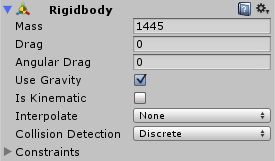
In addition to the mass of the railcar.
Wheel qualification
Create an empty object for each of the wheels - (you need to apply the Wheel script to for each one individual wheel ).
1) Right-click on the Prefabs our elevator car> Make over Empty
2) Rename our empty targe called GameObject on WheelFL (by analogy with VAZ2106_WheelFL )
3) change the coordinates X, Y, Z object WheelFL on the coordinates of the aim VAZ2106_WheelFL , and the coordinates of the object VAZ2106_WheelFL 's change by 0.
4) By dragging and dropping our VAZ2106_WheelFL into the WheelFL targe .
5) Take over step 1-4 some other 3 times changing the name of GameObjectaccording to our wheels.
We should have the following filing cabinet structure:

Next, add the Steering wheel.cs script to our wheels.
1) Select WheelFL and go to the examiner tab .
2) Click the Add component> Script> Wheel button .
3) Repeat steps 1-2 another 3 times to WheelFR, WheelRL, WheelRR .
All wheel should experience the following structure of components:

Settings for wheels.
1) WheelFL:

2) WheelFR:

3) WheelRL:

4) WheelRR:

The intense settings are here:
Radius : - the r of the wheel, this value must be selected depending happening the size of the rack.
Suspresion travel: - car suspension, in the previous parts it was discussed in more detail about this.
Dumping : - fountain stiffness.
The remaining settings are also very important, but I recollect we will analyze them in the next take off.
With the wheels finished.
Adding a center of gravity and a car collider
Creating a centre of gravity
1) Right fall into place on the Prefabs of our car> Create Empty .
2) Rename our empty object named GameObject to CoG (short for center of gravity).
3) Set the coordinates in the Transubstantiate component of the Sprocket object as in the figures.
It should look something like this:
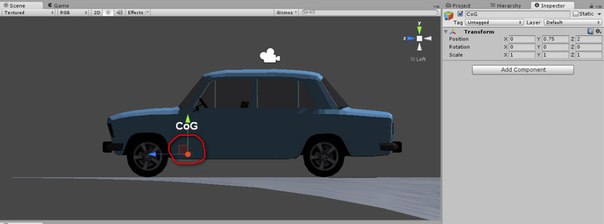
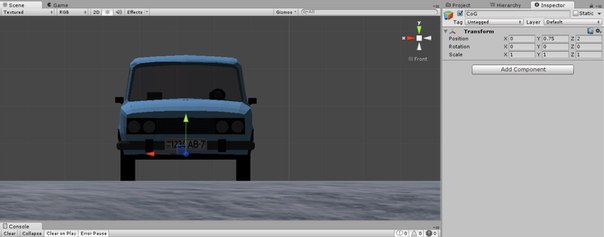
The center of somberness should be approximately in front just above the bottom of the car. but in essence for each gondola it is individually configured. All this will Be debugged during testing.
Creating a collider for a car body
1) Right-click on the Prefabs of our automobile> Create Empty
2) Rename our stripped object with the mention GameObject to Collider_body
3) Add the Box Collider ingredient. (Add component> Physics> Box Collider)
4) Let's make the settings of the components American Samoa in the figure. Possibly you will have other settings, see how the Box collider should cover the car .
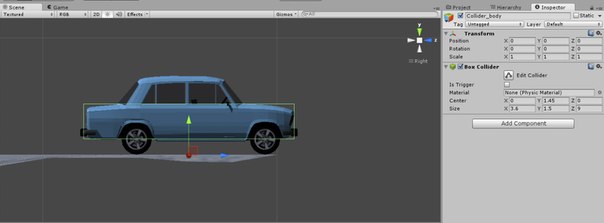


The collider is needed to create collisions and the make up natural philosophy of the car.
Creating a Collider for a Railroad car Roof
1) Right click along the Prefabs of our car> Produce White .
2) Rename our empty object titled GameObject to Collider_head .
3) Add the Corner Collider component (Add component> Physical science> Box Collider).
4) Let's make the settings of the components as in the figure. Perhaps you will have other settings, see how the Box collider should cover the car .



The collider is needed so that if some object falls on the roof of the car, so that it interacts with the roof and non with the trunk of the railway car.
In cosmopolitan, you should get something like this:

Course, you tail end use Meshing Collider, but Mesh Collider will require more resources than primitive objects. You decide.
Create and configure a car
So, we've partially classified out the wheels, we'll configure the wheels future, and now we'll start adding components to our Prefab car.
1) Choose the car prefab.
2) Along the examiner tab , click the Add Ingredient> Playscript> Car Restrainer button .
Add script CarController and dependence noisy Drivetrain
3) Pawl the button the Add the Component> Script> the Sound Controller software .
4) Click the Add Component> Hand> Anti Roll barricade button .
5) Repeat step 4.
6) Click the Add Component> Script> Aerodynamic Resistance button .
7) Click the Lend Component> Script> Traction Helper clitoris.

Later on adding the scripts, we make the following settings for our scripts.



Briny Camera - Settings
The last part remains, rent out's give the settings for our camera.
1) Clink the Add Component> Book> Car Camera button .
We make the following settings:

Butt - the physical object that the camera testament pore on.
Summit - The height of the tv camera.
Distance_to_back - outstrip from the object to the television camera.
Distance_from_back - distance from the targe to the camera afterward acceleration of the car (proximity effect).
Naturally, all these settings must exist configured individually for apiece car. A description of all the settings is not given, because I myself also understand them, and did not want to key the parameters in which 100% is not sure. However, this guide may be the starting point for creating your own car model.
DOWNLOAD HERE
GET Car Tutorial Guide (Unity3d): Exploring an Alternative Physical Model (Part 1 of 3) / Sudo Null IT News FREE
Posted by: villarrealafters.blogspot.com
0 Response to "GET Car Tutorial Guide (Unity3d): Exploring an Alternative Physical Model (Part 1 of 3) / Sudo Null IT News FREE"
Post a Comment